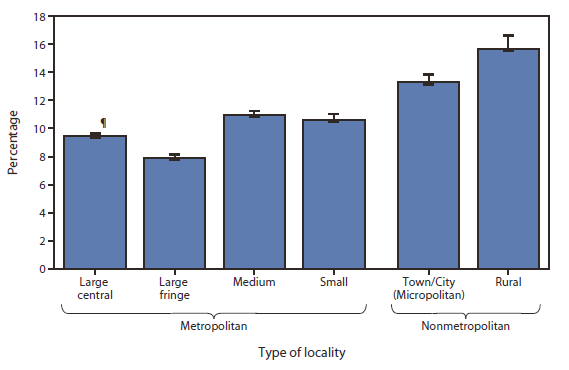Persons using assistive technology might not be able to fully access information in this file. For assistance, please send e-mail to: mmwrq@cdc.gov. Type 508 Accommodation and the title of the report in the subject line of e-mail.
QuickStats: Percentage of Adults Aged 18–64 Years Who Reported Fair or Poor Health,* by Type of Locality† — National Health Interview Survey, 2008–2010§

* Respondents were asked, "Would you say your health in general is excellent, very good, good, fair, or poor?"
† Counties were classified into urbanization levels based on a classification scheme that considers metropolitan/nonmetropolitan status, population, and other factors.
§ Estimates are based on household interviews of a sample of the civilian, noninstitutionalized U.S. population and are derived from the National Health Interview Survey family core and sample adult questionnaires.
¶ 95% confidence interval.
The percentage of adults aged 18–64 years reporting fair or poor health during 2008–2010 was lowest among those residing in large fringe metropolitan counties (7.9%) and highest among those in the most rural counties (15.7%). Compared with large fringe metropolitan counties, the prevalence of fair or poor health was 20% higher in large central metropolitan counties (9.5%), 39% higher in medium metropolitan counties (11.0%), 34% higher in small metropolitan counties (10.6%), 68% higher in nonmetropolitan town/city (micropolitan) counties (13.3%), and 99% higher in nonmetropolitan rural counties (15.7%).
Sources: National Health Interview Survey. Available at http://www.cdc.gov/nchs/nhis.htm.
Ingram DD, Franco SJ. NCHS urban-rural classification scheme for counties. National Center for Health Statistics. Vital Health Stat 2012;2(154). Available at http://www.cdc.gov/nchs/data/series/sr_02/sr02_154.pdf.
Reported by: Sheila J. Franco, sfranco@cdc.gov, 301-458-4331; Deborah D. Ingram, PhD.
Alternate Text: The figure above shows the percentage of adults aged 18-64 years who reported fair or poor health status during 2008-2010, by type of locality. The percentage of adults aged 18-64 years reporting fair or poor health during 2008-2010 was lowest among those residing in large fringe metropolitan counties (7.9%) and highest among those in the most rural counties (15.7%). Compared with large fringe metropolitan counties, the prevalence of fair or poor health was 20% higher in large central metropolitan counties (9.5%), 39% higher in medium metropolitan counties (11.0%), 34% higher in small metropolitan counties (10.6%), 68% higher in nonmetropolitan town/city (micropolitan) counties (13.3%), and 99% higher in nonmetropolitan rural counties (15.7%).
Use of trade names and commercial sources is for identification only and does not imply endorsement by the U.S. Department of
Health and Human Services.
References to non-CDC sites on the Internet are
provided as a service to MMWR readers and do not constitute or imply
endorsement of these organizations or their programs by CDC or the U.S.
Department of Health and Human Services. CDC is not responsible for the content
of pages found at these sites. URL addresses listed in MMWR were current as of
the date of publication.
All MMWR HTML versions of articles are electronic conversions from typeset documents.
This conversion might result in character translation or format errors in the HTML version.
Users are referred to the electronic PDF version (http://www.cdc.gov/mmwr)
and/or the original MMWR paper copy for printable versions of official text, figures, and tables.
An original paper copy of this issue can be obtained from the Superintendent of Documents, U.S.
Government Printing Office (GPO), Washington, DC 20402-9371;
telephone: (202) 512-1800. Contact GPO for current prices.
**Questions or messages regarding errors in formatting should be addressed to
mmwrq@cdc.gov.


